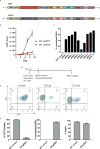An "off-the-shelf" fratricide-resistant CAR-T for the treatment of T cell hematologic malignancies
- PMID: 29483708
- PMCID: PMC6102094
- DOI: 10.1038/s41375-018-0065-5
An "off-the-shelf" fratricide-resistant CAR-T for the treatment of T cell hematologic malignancies
Abstract
T cell malignancies represent a group of hematologic cancers with high rates of relapse and mortality in patients for whom no effective targeted therapies exist. The shared expression of target antigens between chimeric antigen receptor (CAR) T cells and malignant T cells has limited the development of CAR-T because of unintended CAR-T fratricide and an inability to harvest sufficient autologous T cells. Here, we describe a fratricide-resistant "off-the-shelf" CAR-T (or UCART7) that targets CD7+ T cell malignancies and, through CRISPR/Cas9 gene editing, lacks both CD7 and T cell receptor alpha chain (TRAC) expression. UCART7 demonstrates efficacy against human T cell acute lymphoblastic leukemia (T-ALL) cell lines and primary T-ALL in vitro and in vivo without the induction of xenogeneic GvHD. Fratricide-resistant, allo-tolerant "off-the-shelf" CAR-T represents a strategy for treatment of relapsed and refractory T-ALL and non-Hodgkin's T cell lymphoma without a requirement for autologous T cells.
Conflict of interest statement
Figures






Similar articles
-
Base-edited CAR T cells for combinational therapy against T cell malignancies.Leukemia. 2021 Dec;35(12):3466-3481. doi: 10.1038/s41375-021-01282-6. Epub 2021 May 25. Leukemia. 2021. PMID: 34035409 Free PMC article.
-
CD7-edited T cells expressing a CD7-specific CAR for the therapy of T-cell malignancies.Blood. 2017 Jul 20;130(3):285-296. doi: 10.1182/blood-2017-01-761320. Epub 2017 May 24. Blood. 2017. PMID: 28539325 Free PMC article.
-
High-Affinity GD2-Specific CAR T Cells Induce Fatal Encephalitis in a Preclinical Neuroblastoma Model.Cancer Immunol Res. 2018 Jan;6(1):36-46. doi: 10.1158/2326-6066.CIR-17-0211. Epub 2017 Nov 27. Cancer Immunol Res. 2018. PMID: 29180536 Free PMC article.
-
Chimeric antigen receptor T cells (CAR-T) for the treatment of T-cell malignancies.Best Pract Res Clin Haematol. 2019 Dec;32(4):101097. doi: 10.1016/j.beha.2019.101097. Epub 2019 Oct 18. Best Pract Res Clin Haematol. 2019. PMID: 31779968 Review.
-
Use of Cell and Genome Modification Technologies to Generate Improved "Off-the-Shelf" CAR T and CAR NK Cells.Front Immunol. 2020 Aug 7;11:1965. doi: 10.3389/fimmu.2020.01965. eCollection 2020. Front Immunol. 2020. PMID: 32903482 Free PMC article. Review.
Cited by
-
Targeting CD5 chimeric antigen receptor-engineered natural killer cells against T-cell malignancies.Exp Hematol Oncol. 2024 Oct 26;13(1):104. doi: 10.1186/s40164-024-00577-5. Exp Hematol Oncol. 2024. PMID: 39462383 Free PMC article.
-
Chimeric Antigen Receptor-T Cell Therapy for Lymphoma: New Settings and Future Directions.Cancers (Basel). 2023 Dec 21;16(1):46. doi: 10.3390/cancers16010046. Cancers (Basel). 2023. PMID: 38201473 Free PMC article. Review.
-
Multidimensional Analyses of Donor Memory-Like NK Cells Reveal New Associations with Response after Adoptive Immunotherapy for Leukemia.Cancer Discov. 2020 Dec;10(12):1854-1871. doi: 10.1158/2159-8290.CD-20-0312. Epub 2020 Aug 21. Cancer Discov. 2020. PMID: 32826231 Free PMC article.
-
Naturally selected CD7 CAR-T therapy without genetic editing demonstrates significant antitumour efficacy against relapsed and refractory acute myeloid leukaemia (R/R-AML).J Transl Med. 2022 Dec 14;20(1):600. doi: 10.1186/s12967-022-03797-7. J Transl Med. 2022. PMID: 36517851 Free PMC article.
-
CD7 CAR T Cells for the Therapy of Acute Myeloid Leukemia.Mol Ther. 2019 Jan 2;27(1):272-280. doi: 10.1016/j.ymthe.2018.10.001. Epub 2018 Oct 4. Mol Ther. 2019. PMID: 30391141 Free PMC article.
References
-
- Karrman K, Johansson B. Pediatric T-cell acute lymphoblastic leukemia. Genes, Chromosomes and Cancer. 2017;56(2):89–116. - PubMed
-
- Gökbuget N, Arnold R, Böhme A, Fietkau R, Freund M, Ganser A, et al. Acute Leukemias. Springer Berlin Heidelberg; Berlin, Heidelberg: 2008. Treatment of Adult ALL According to Protocols of the German Multicenter Study Group for Adult ALL (GMALL) pp. 167–176.
-
- Goldberg JM, Silverman LB, Levy DE, Dalton VK, Gelber RD, Lehmann L, et al. Childhood T-cell acute lymphoblastic leukemia: the Dana-Farber Cancer Institute acute lymphoblastic leukemia consortium experience. Journal of clinical oncology : official journal of the American Society of Clinical Oncology. 2003 Oct 01;21(19):3616–3622. - PubMed
Publication types
MeSH terms
Substances
Grants and funding
LinkOut - more resources
Full Text Sources
Other Literature Sources
Research Materials

